Before I discovered bullet journaling, I used to keep at least 3 different planners — a calendar planner, a school to-do list, and a diary. I loved that each notebook was optimized for each task, but it drove me crazy having to manage three different planners.
When I started to notice a pattern in wasted time, forgotten tasks and unused pages, I decided to try a bullet journal notebook.
Bullet journaling is an analog journaling system invented by New York-based designer Ryder Caroll. It’s a great alternative to premade planners because it allows you to personalize your bullet journal pages to fit your lifestyle, goals, and aesthetic.
If you’re looking for a more flexible option that can adjust to your needs and goals, here are 10 bullet journal page ideas to increase your productivity and achieve your goals.
Where do you start?
Starting your own bullet journal can be overwhelming and intimidating — where do you start? What pages should you add?
A few minutes of self-reflection can go a long way in helping you design a journal that fits your likes, dislikes, and goals.
A few minutes of self-reflection can go a long way in helping you design a journal that fits your likes, dislikes, and goals. For a beginner’s overview of the bullet journal method, check out my article, Kickstart Your Goals by Starting a Bullet Journal.
After brainstorming your preferences and goals, it’s time to jump in and start creating! I understand the fear of messing up and the temptation to not start until you have everything planned 100%. But try to remember that done is better than perfect!
Let’s break down the different bullet journal spreads.
Bullet Journal Page Ideas
1. Key Page
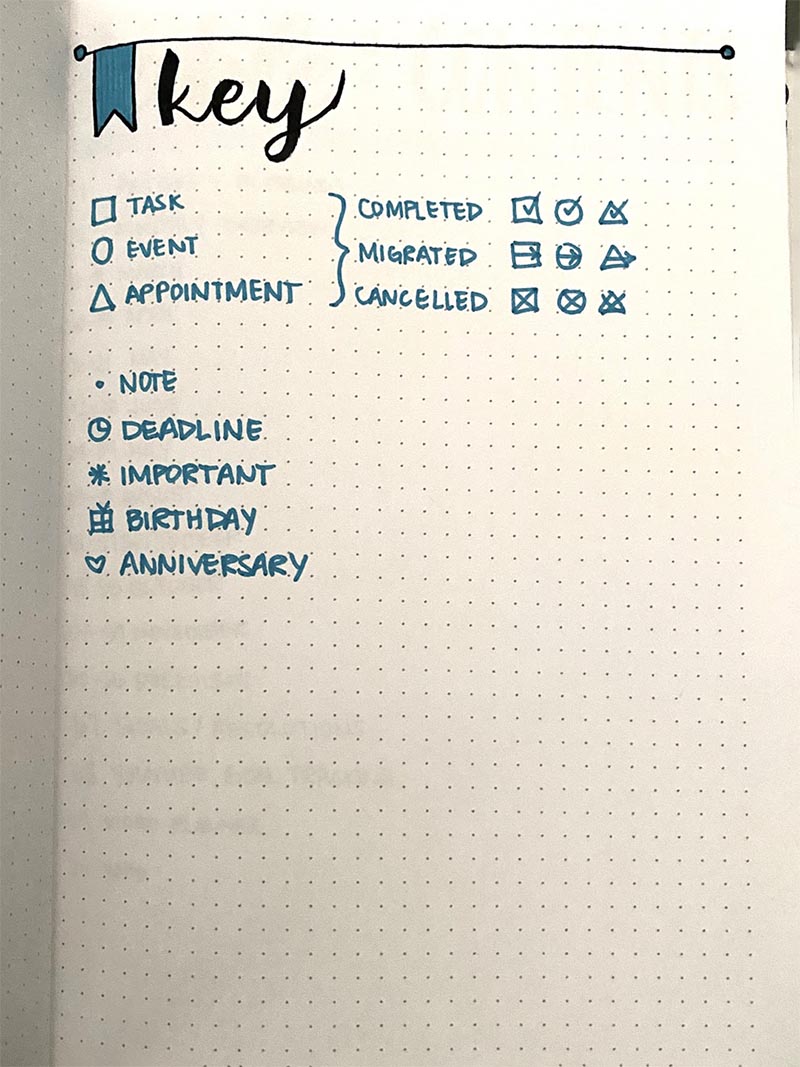
It’s a good idea to make the first page in your bullet journal a Key for your journal. This page is useful for defining icons or identifying a color code you plan on using frequently throughout your journal. Try to keep your key simple by using icons that you can remember. Having too many icons can get confusing.
Notice how I distinguish between tasks, events and appointments, and how I mark whether they’ve been completed, moved, or cancelled. This helps with rapid logging.
2. Table of Contents
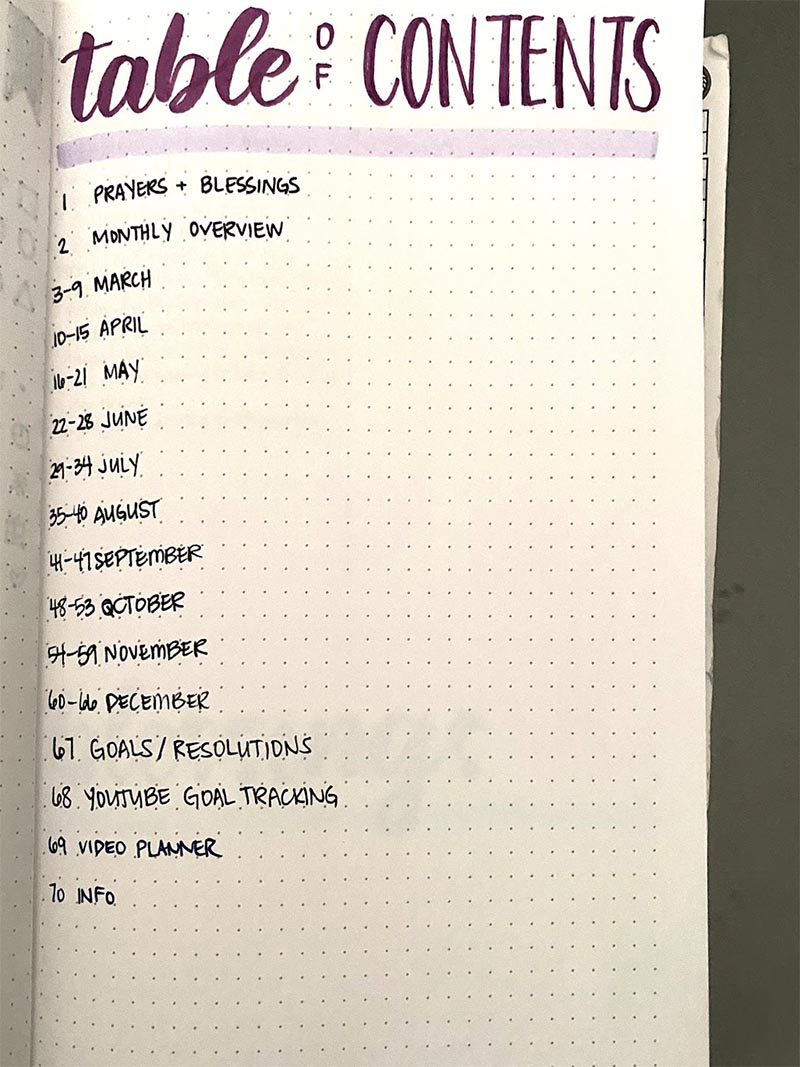
After putting page numbers on all the pages of your bullet journal, consider including a table of contents page towards the beginning—that way, when you fill in the pages, you can easily document where everything is located.
Notice how I note the range of pages for each month rather than writing out an overly granular list, like the following:
- Page 35: August Month-At-A-Glance
- Page 36: August Habit Tracker
- Page 37: August Week 1
Writing out every single detail is too tedious and actually makes it more difficult to find what you are looking for. Less is more here.
3. Monthly Overview
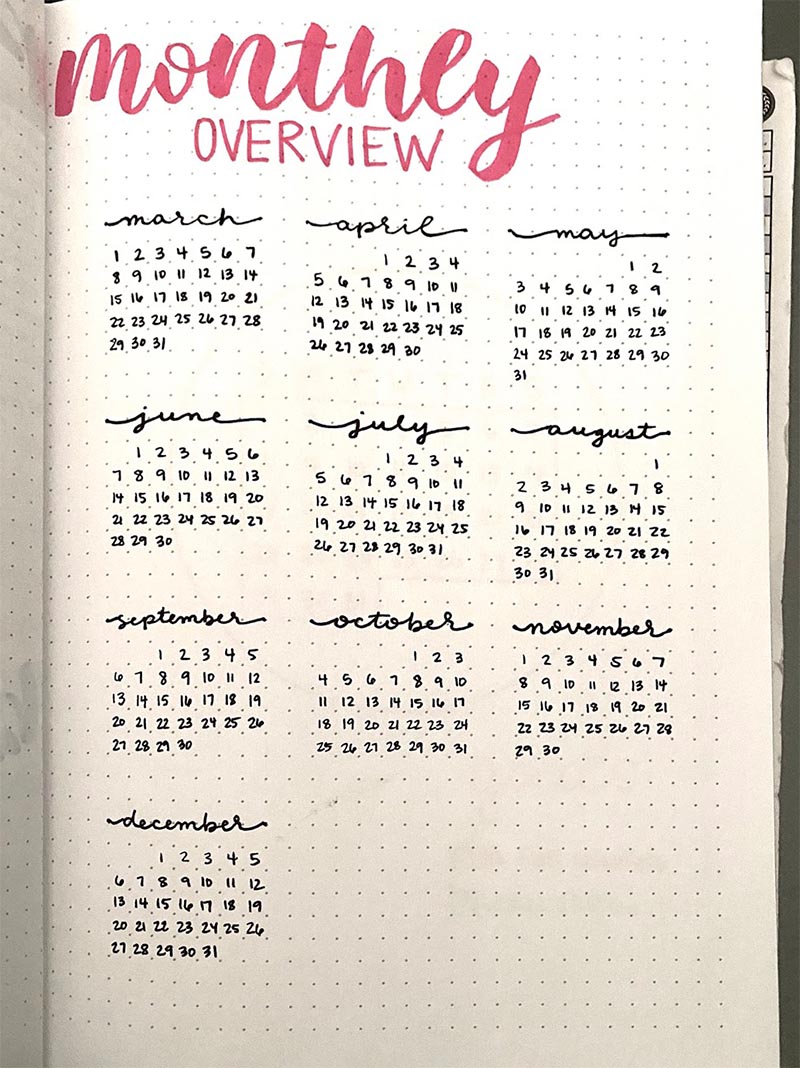
This page shows all of the upcoming months. You can have a page that overviews the next three months, or all of the months that appear throughout the bullet journal (as seen in the photo). This page can be used to identify big events, birthdays, anniversaries or vacations to help you plan for the future.
For those who like using color, you could use different colored highlighters to mark the dates that represent these days, so they easily catch your attention.
I especially like using this page when planning for future doctor appointments for my daughter. I can get an idea of what the upcoming months look like without having to flip through multiple pages in my bullet journal.
4. Month-at-a-Glance
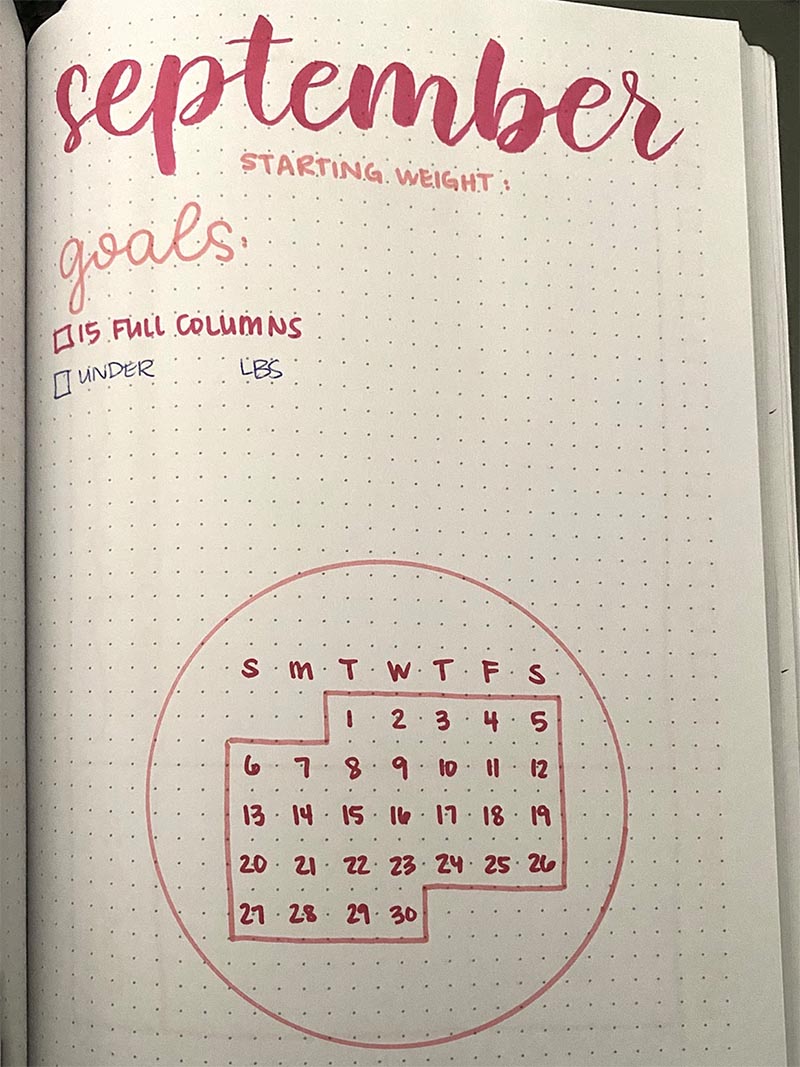
A Month-at-a-Glance page is helpful to include in your journal prior to your weekly spread pages. Use this page to jot down tasks you need to complete throughout the month, identify personal goals for the month, or leave some space for future “brain dumps.”
Brain dumps occur when you write down every thought running through your head. Oftentimes, these thoughts jump from one to another, circulating and unresolved. A brain dump allows you to get all of your thoughts on paper so that you can organize them and tackle them head on.
I like to document my weight at the beginning of each month, so that I can look back and keep a monthly log of my weight loss progress. I also write some of my major goals for the month on this page. The remaining space on the page is for general notes and doodles.
5. Weekly Spread
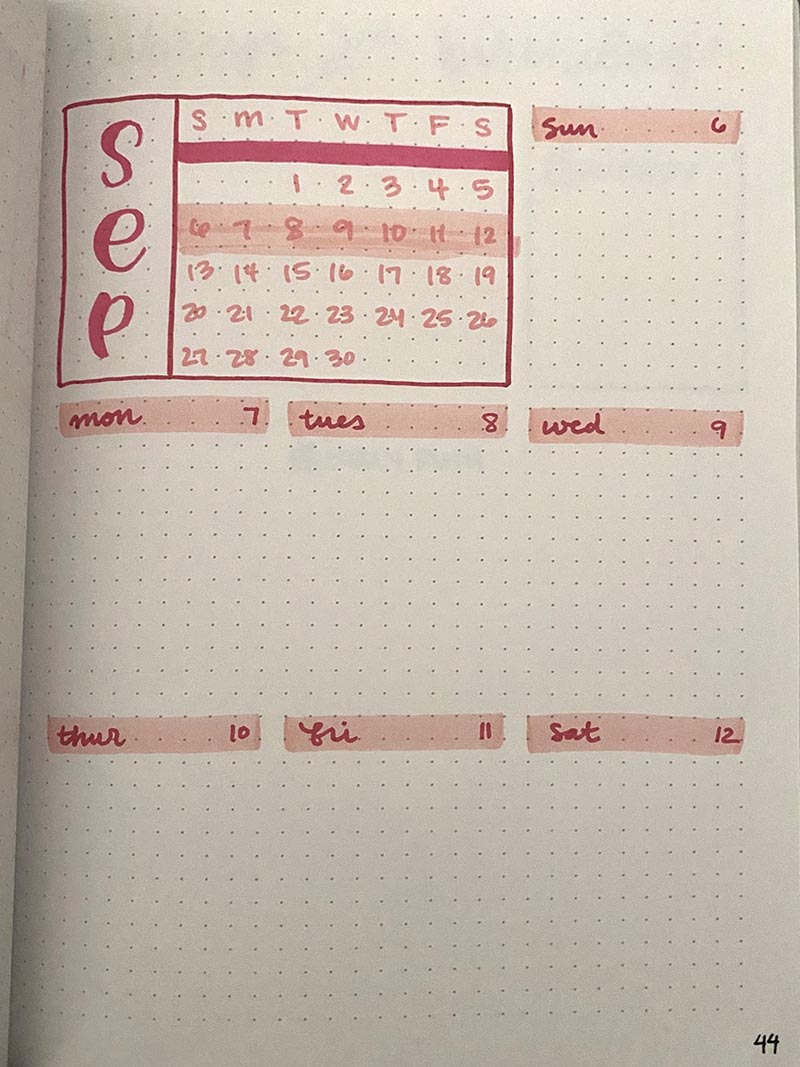
Use weekly spread pages to provide more detailed notes for day-to-day plans. Here is where you can keep track of events, tasks, and appointments. Remember to use the icons you defined on your Key Page.
On my weekly spread pages, I like to include an image of the month we are in and highlight the current week. I also leave the backside of my pages blank for daily “brain dumps.” During a time in my life where I had a number of doctor appointments, I would write my questions for the doctors on these blank sides, so I would remember to get answers to my questions (and then have a place to document them).
I have found creating these pages to be very therapeutic. To watch a timelapse of me designing my most recent journal, check out my Bullet Journal Tutorial on my Limabean Living YouTube channel.
6. Monthly Goal/Habit Tracker
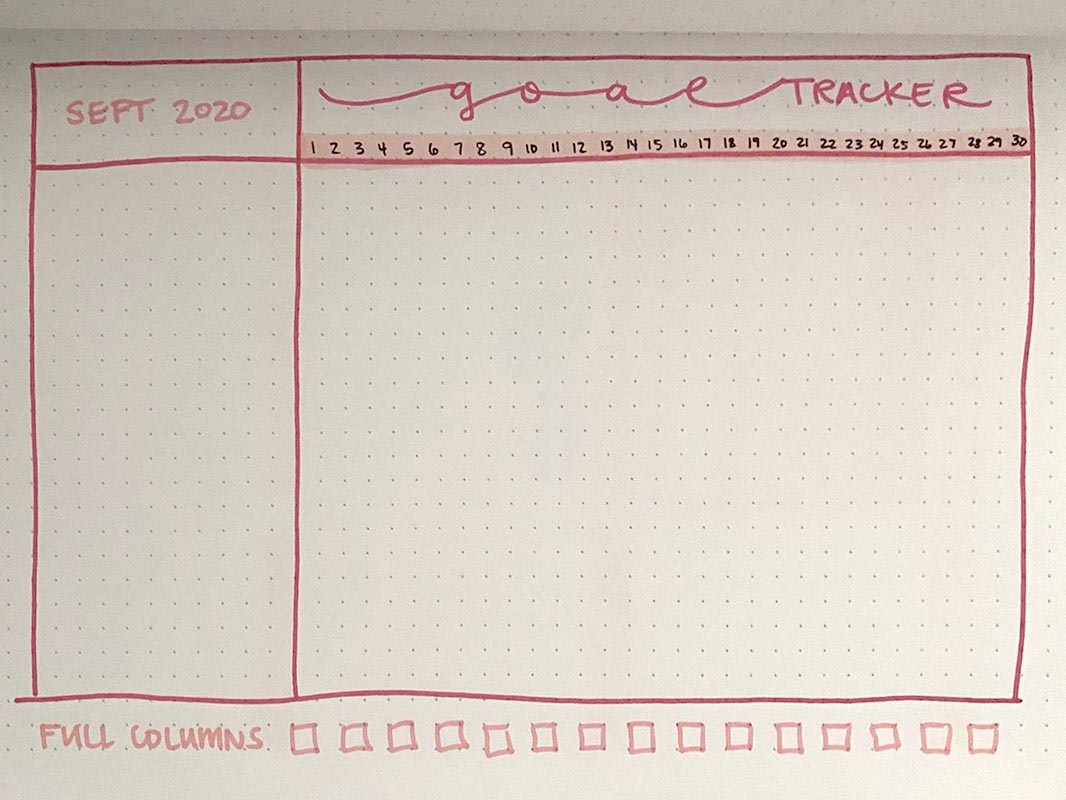
A goal tracker is a great page to include in your bullet journal if you hope to improve your habits and recognize patterns in your behaviour that lead to success in achieving your goals.
To create this page, make a column for each day of the month and then write your goals for each day on each row. These goals can be simple or challenging, such as brushing and flossing your teeth or doing a 40-minute cardio workout. When you have completed one of the items, check it off or fill in the corresponding square with a highlighter. Ideally, at the end of the month, the entire page will be filled in.
Some months are more successful than others. As you can see in the side-by-side photo comparison below, I was far more successful in completing a full column in March 2020 than I was in March of the previous year.
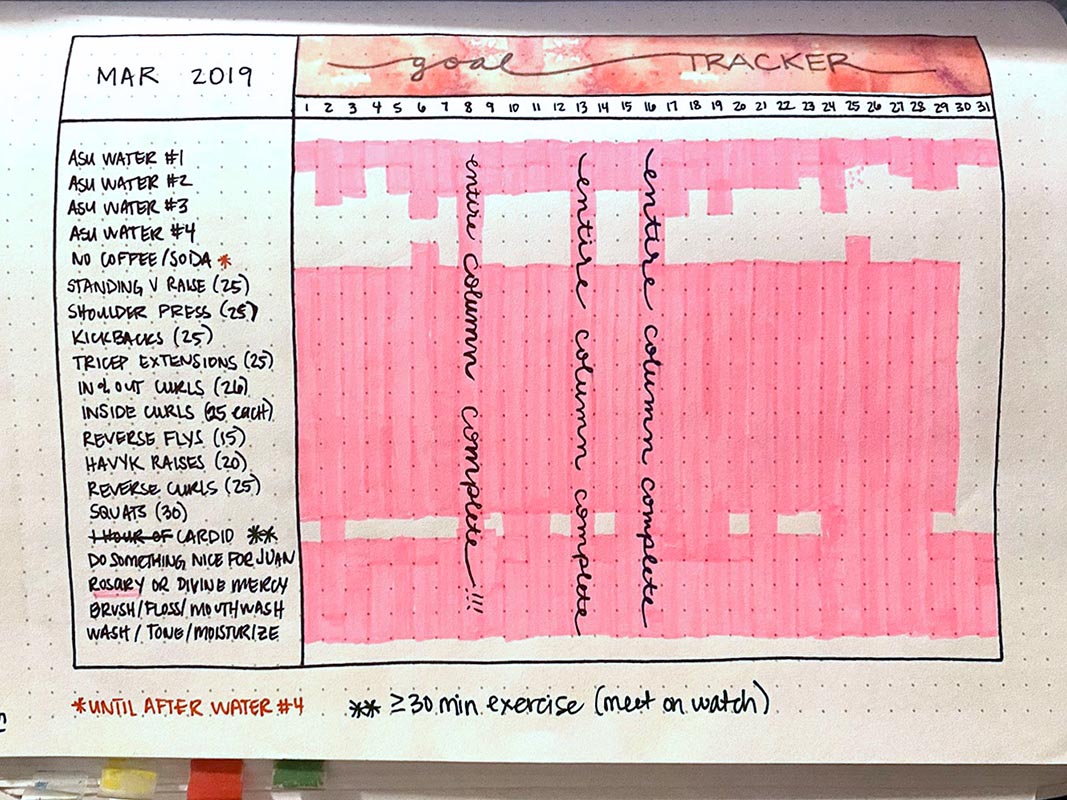
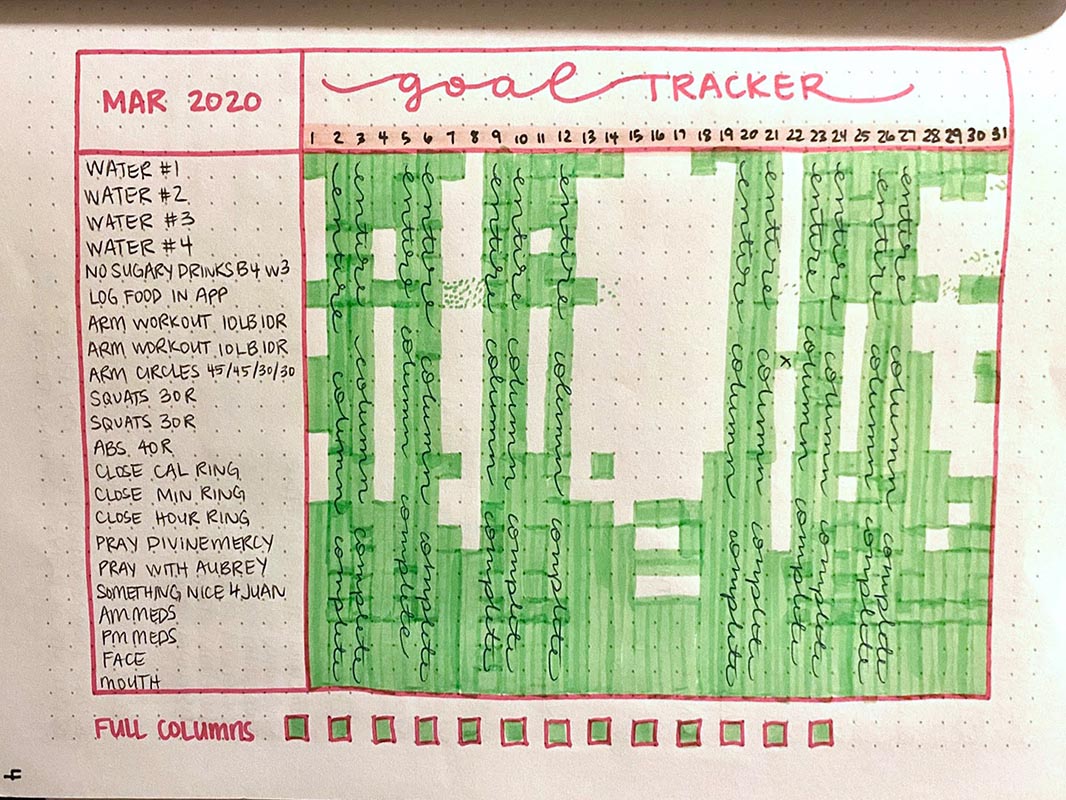
Despite being a year apart, these pages share many goals. I consolidated my arm workout and added a variety of other workout goals to my list. I’ve also adjusted my “no coffee/soda” rule to make it more attainable but still challenging.
To this day, there are still goals I struggle to achieve. But seeing the improvement in the number of full columns completed allows me to see where I’ve grown. Every month, I try to set realistic goals and stretch myself.
In one of my Limabean Living YouTube videos, I share in more detail how I utilize this page to achieve my yearly goals: New Year Goal Tracking in Bullet Journal.
If you are looking to increase your productivity, you may consider adding the following goals to your goal tracker:
- Listen to helpful podcasts
- Complete daily chores (Tip: break up chores by day, so you don’t feel overwhelmed)
- Study for 1 hour
- Complete self-care routine
- 10-minute speed clean
- Prep supplies for next morning
7. Gratitude Log
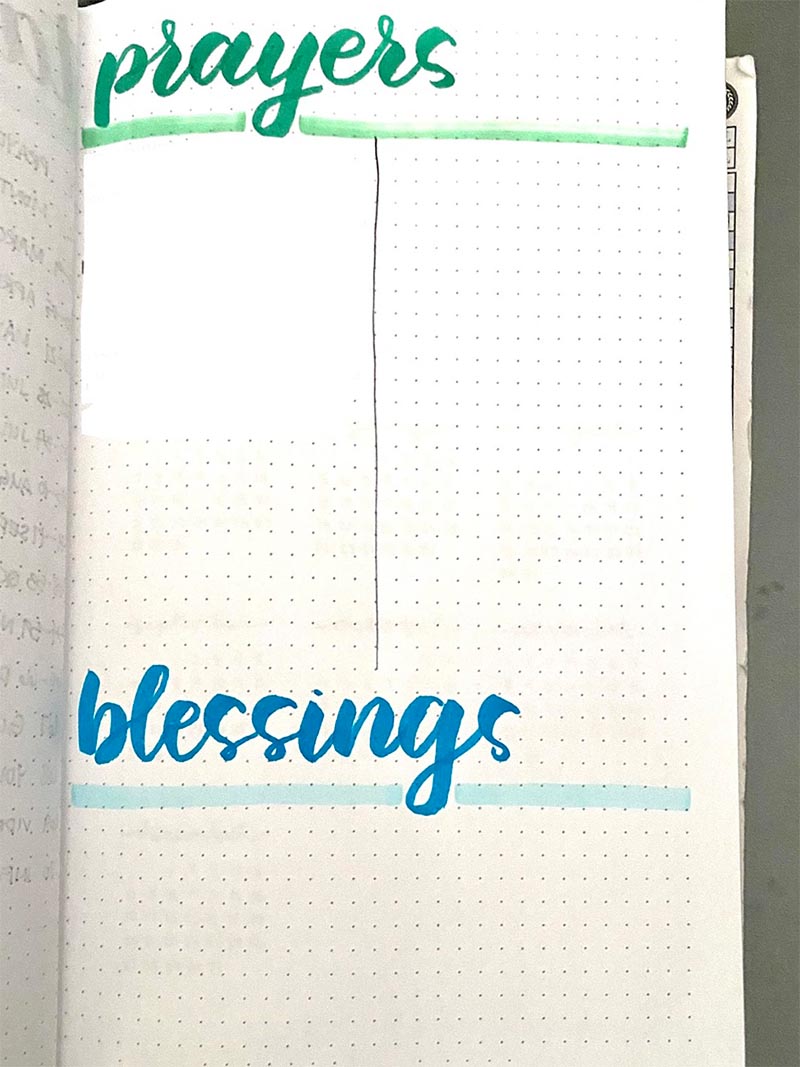
If you find yourself struggling to be positive, consider adding a gratitude log to your bullet journal. On this page, you can identify things you’re thankful for. You may even want to add “Keep a Gratitude Log” as a goal in your goal tracker. Having an attitude of gratitude can make even the toughest of times bearable, and even enjoyable.
8. Weight Tracker
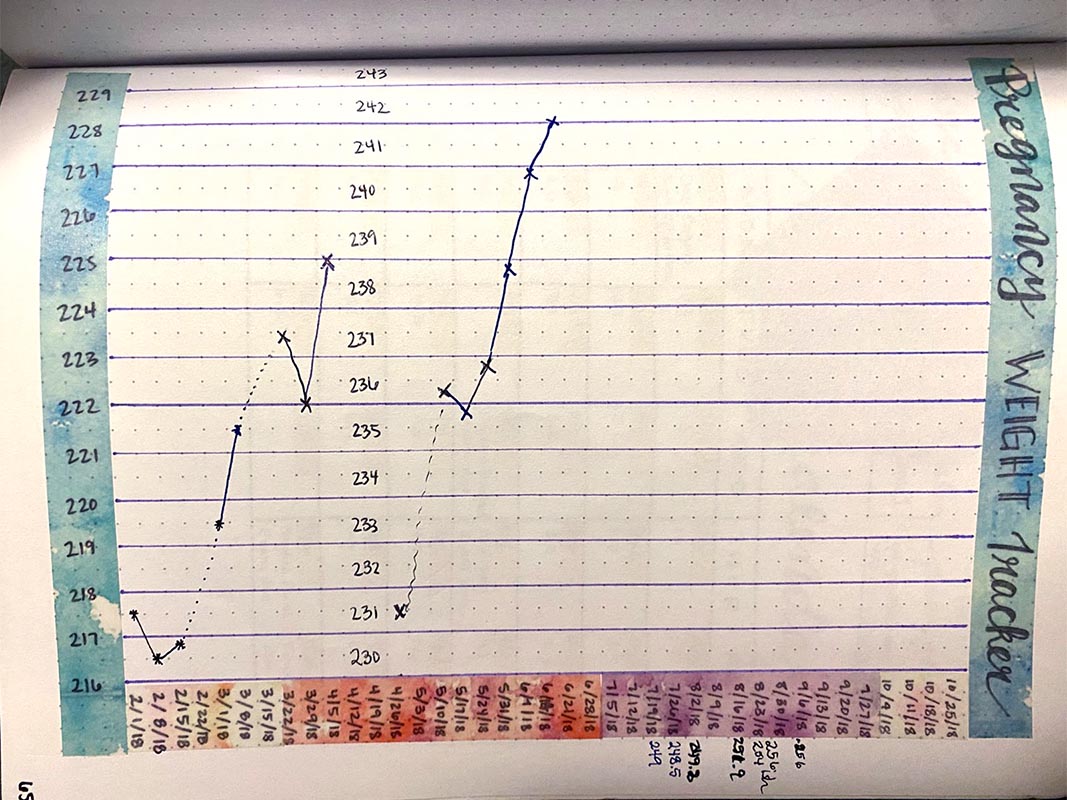
If you are a visual person and have weight loss or weight gain goals, consider adding a Weight Tracker page in your bullet journal. You can log your weight once a week by drawing a dot and connecting successive dots with a solid line. If you miss a week, connect the dots with a dashed line.
I decided to track my weight gain during my first pregnancy. As you can see, I gained more weight than I anticipated, so I modified the page to adjust the scale.
9. Meal Planner
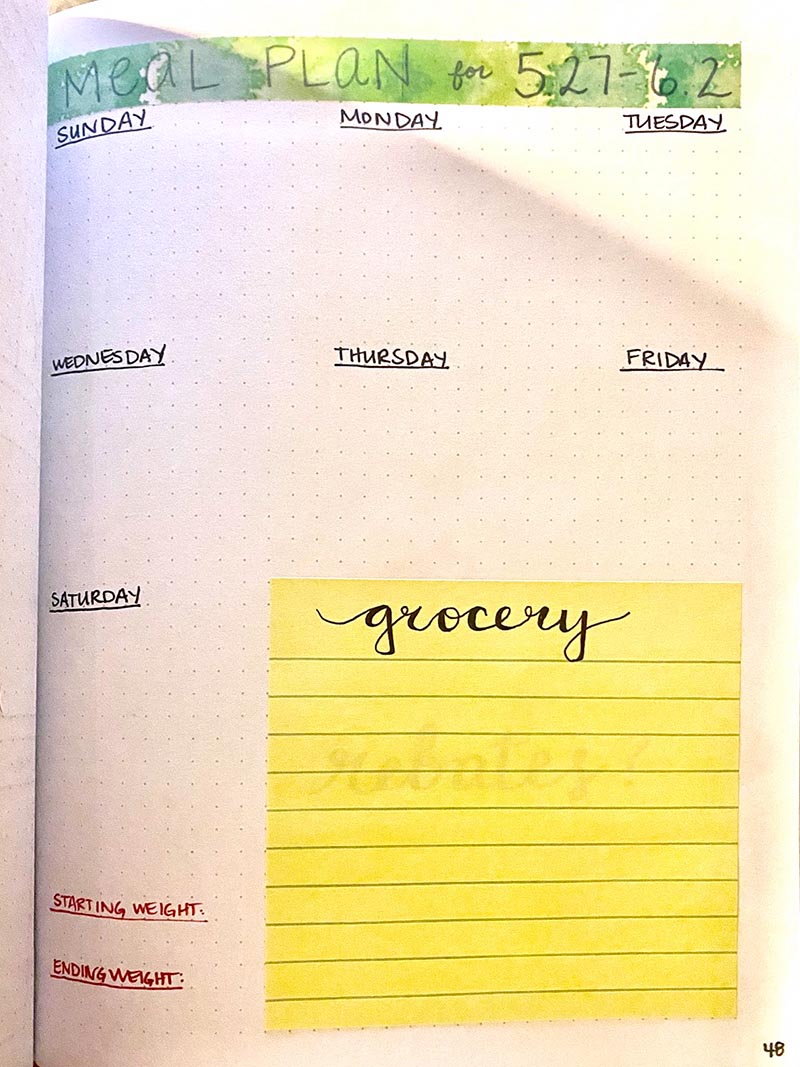
Are you the type of person who gets stressed thinking about what you will make for dinner? If you find yourself overwhelmed and overbuying when you go grocery shopping, consider adding a meal planning page to your journal.
Use this page to plan your meals for the week ahead and jot down which ingredients you need to buy on the sticky note. Using a sticky note makes it easy for you to bring your grocery list with you to the store!
Underneath the sticky note, I would often write a reminder to myself to submit my receipts to rebate apps, like ibotta, so that I could bring home some extra cash. (If you want to learn more about how I’ve saved $500+ using ibotta, check out my Limabean Living video on Saving Money with Rebate Apps.)
10. Yearly Goals
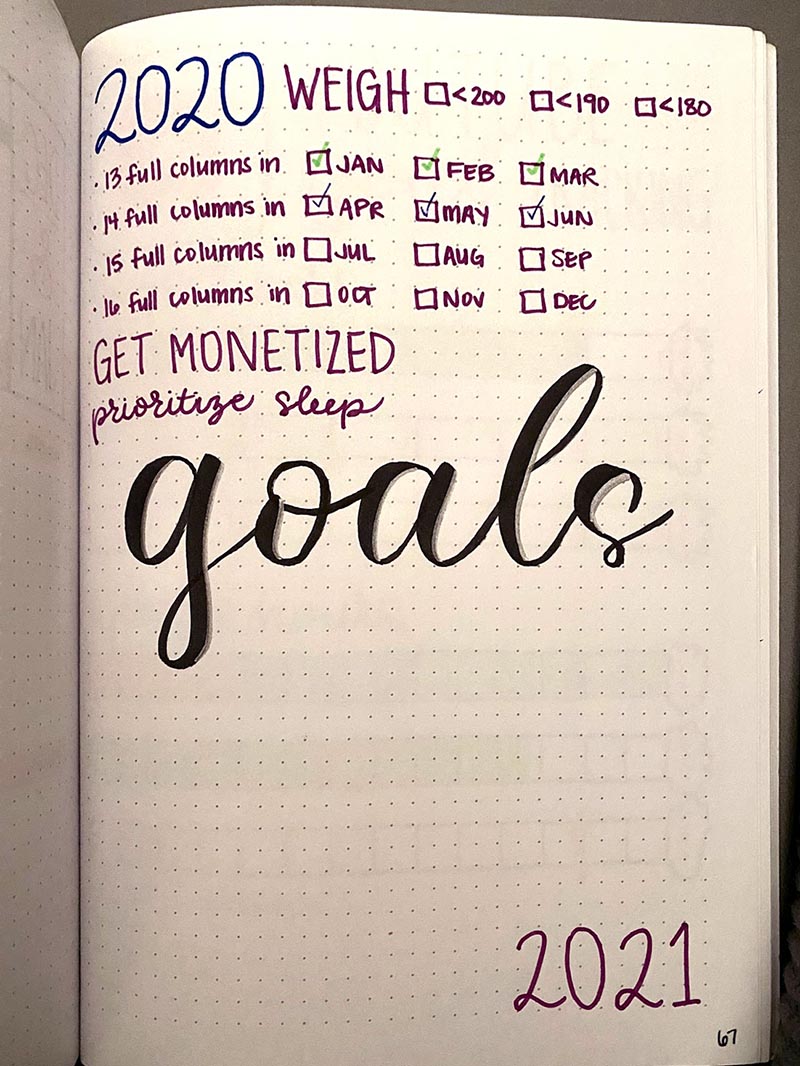
It is a good idea to have a page where you document long-term goals. Think of this page as a “New Year’s Resolution” page. Unlike the Monthly Goal Tracker page that focuses on smaller, quickly attainable goals, this page identifies the “big picture” goals.
Identifying your big goals is an important step in figuring out the little goals that will help you get there.
For example, suppose your long-term goal is to have healthier skin. Identifying this big goal can help you set month goals such as: drink 8 glasses of water each day, wash face (morning), wash face (evening), moisturize, apply sunscreen, etc.
I left the bottom half of this page blank so that at the end of 2020, I can set goals for 2021 that build off my successes and shortcomings in the current year. An important part of setting goals is to be realistic and honest with yourself. If you find that you consistently fail to meet your goals, try setting even smaller goals that lead you in the same direction. This is how you train your brain to create productive habits.
Journals evolve with you!
As you grow and evolve, so will your journal. The important step is to get started. Try new bullet journal ideas. Experiment with different page layouts. You may find some of these bullet journal page ideas don’t work for you, and that’s ok.
I am currently planning my 6th bullet journal, and none of my journals are exactly the same. My style/aesthetic has evolved to fit my current preference, and so will yours. You may even find it refreshing to look back and see how you and your journals have changed over time. Happy journaling!
